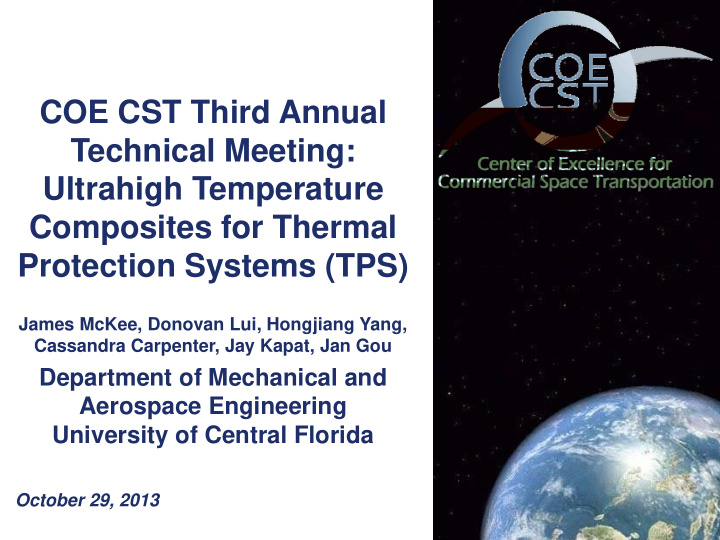



COE CST Third Annual Technical Meeting: Ultrahigh Temperature Composites for Thermal Protection Systems (TPS) James McKee, Donovan Lui, Hongjiang Yang, Cassandra Carpenter, Jay Kapat, Jan Gou Department of Mechanical and Aerospace Engineering University of Central Florida October 29, 2013 COE CST Third Annual Technical Meeting (ATM3) October 28-30, 2013
Overview • Team Members • Purpose of Task • Research Methodology • Results or Schedule & Milestones • Next Steps • Contact Information COE CST Third Annual Technical Meeting (ATM3) October 28-30, 2013
Team Members Principle Investigators • Jan Gou - Composites design and manufacturing, composites mechanics • Jay Kapat - Heat transfer, film cooling, aerodynamics testing • Ali Gordon - Thermo-mechanical testing and modeling Graduate Students • James McKee, Hongjiang Yang : Composites TPS design & manufacturing • Donovan Lui : Ablation testing • Cassandra Carpenter : Aerothermal modeling COE CST Third Annual Technical Meeting (ATM3) October 28-30, 2013
Purpose of Task Develop ultrahigh temperature , light weight , low erosion , and cost effective ablative thermal protection systems with embedded health monitoring for inherent safety and real-time assessment of TPS performance in hypersonic space vehicles Reentry Vehicles COE CST Third Annual Technical Meeting (ATM3) October 28-30, 2013
Purpose of Task RELEVANCE TO COMMERCIAL SPACE INDUSTRY • Ultra-high temperature, light weight, low erosion, and cost effective thermal protection systems (TPS) are enabling technologies for viable commercial space transportation vehicles and their high-temperature systems. STATEMENT OF WORK • Develop nanocomposites TPS with embedded health monitoring for inherent safety and real-time assessment of hypersonic TPS applications. • Provide an analysis tool for the aerothermal modeling of reentry vehicles and rocket propulsion. • Provide an analysis tool for thermal degradation modeling of new ablative materials. • Provide ablation sensing to monitor the structural health of the ablative thermal protection system. COE CST Third Annual Technical Meeting (ATM3) October 28-30, 2013
Current Approach • PICA: Phenolic Impregnated Carbon Ablator • SICA: Silicone Impregnated Carbon Ablator • Carbon/Carbon Composites Problems • The resulting chars are structurally weak and susceptible to mechanical erosion, severely reducing the lifetime of the TPS. Reducing spallation or erosion of the char can enable use of less ablative materials thereby reducing the total weight of TPS. • The evaluation of ablation performance needs to consider the structural integrity of TPS structures • Recession monitoring is most important measurement to the aerothermal analysis of the TPS structure. This measurement provides critical information about how the TPS mass and shape changes during the fight. COE CST Third Annual Technical Meeting (ATM3) October 28-30, 2013
Ablative TPS Design - Nanocomposites Approach TPS Materials Design Bi-layer thermal protective coating Nanocomposite prepreg systems Nanocomposite thermal protective coating COE CST Third Annual Technical Meeting (ATM3) October 28-30, 2013
Recommend
More recommend